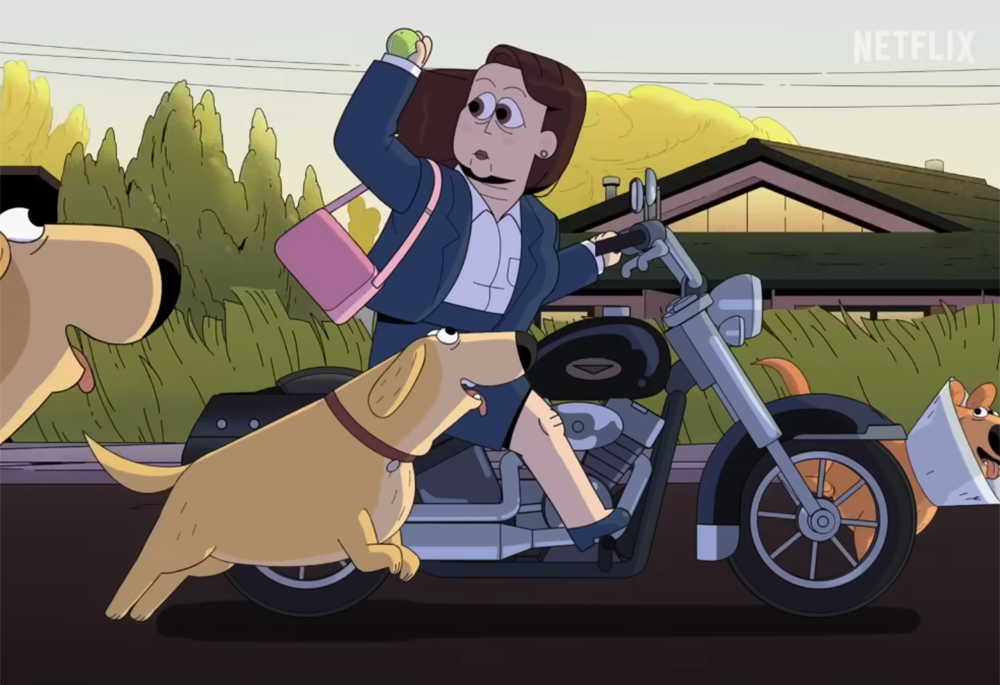
Lead character Carol Kohl is pictured in this screengrab from the trailer for "Carol & The End of the World" (NCR screengrab/YouTube/Netflix)
When you walk into any given Catholic church, you will see subtle variations. There might be stone, wood or marble. There might be a modern sound system or crackling, outdated speakers. There may or may not be stained glass windows depicting saints or a scene from the Bible. However, one constant you will always see, no matter the church, is a crucifix.
Often perceived as the ultimate symbol for "Catholic guilt," the crucifix nonetheless contains rich meaning: the sign of human salvation, by means of divine sacrifice. Yet, Christ's death on the cross is not an ending.
"Carol & The End of the World" is, at first glance, entirely about an ending. The adult animated show continues the trend of exploring the modern dystopian can of worms that a global pandemic cracked open four years ago. In the show, a mysterious planet arrives on the scene, and after exhaustive global analysis it is determined that Keppler will destroy the Earth in under a year. This revelation understandably causes a lot of chaos on Earth, with many deciding to give up on their mundane lives and venture out to travel around the world or otherwise seek a hedonistic release in the short time remaining.
Carol Kohl is not one of those people. Carol, in fact, is someone who is so taken with normalcy (with "the before times"), that early on in the show she actually gets in trouble for hanging out too much at an abandoned Applebee's. Other characters try to encourage her to "live a little," but she's just not that into it. Carol is not motivated by the prospect of some extra juicy meaning to be found "out there." And she is very resistant to any attempts by others to make meaning for her, even if the concern is genuine.
Meanwhile, the horizon is dominated day and night by the green glow of the planet that is bearing down on Earth, a visual reminder and symbol of what's to come.
The Latin phrase memento mori, familiar to many Catholics, comes to mind here: "Remember your death." It is a phrase that calls for contemplation of our mortal end, just like Keppler in the show. But what if Keppler didn't just represent an ending?
That's the thing about Catholics and our crucifixes. The crucifixion is not the "end" of the Incarnation. Salvation is not a singular, fixed point in time — although it is tempting to think of it that way as our bodies move through linear time. But as humans continue to advance beyond walls and borders through technology, the pains and anxieties of the collective become just as omnipresent as the celebrations and joys. Where in these fleshy bodies can we put all of the joys and sorrows of the global human race? Our reptilian brains are connected via the internet to almost everyone else on Earth, and so many of us spend our time on disinformation, conspiracies and bullying. We have bills to pay and families to feed, all while the world feels like it is ending; why do we have so little capacity for kindness?
The Latin phrase memento mori, familiar to many Catholics, comes to mind here. … It is a phrase that calls for contemplation of our mortal end, just like Keppler in the show. But what if Keppler didn't just represent an ending?
Carol's resistance to going out and living a little seems strange at first. She putters around town while her parents are busy becoming nudists and forming a polyamorous relationship and her sister Elena travels the world. And yet, for all the apparent lack of excitement in Carol's world, she is able to see and find things that the hedonists miss completely, like a little boy dressed as a vampire going door to door all alone and shouting, "Trick or treat!" No one else seems concerned about where his parents are, or whether he is safe, until Carol takes charge of the situation. Her life is organized around valuing the present moment, despite the knowledge of the certain end — though she would probably just call it being herself.
Other characters cosplay with meaning-making via a kind of spiritual tourism, like a couple who invite Carol to a dinner party where everyone is raving about a recent trip to Thailand and dressed in the orange robes of monks. They are not interested in real meaning. They have simply found their own exotic distraction.
For her part, Carol gets an office job. Yes, they still exist — or at least, this one does. The familiarity of the open-floor concept and fluorescent lighting makes Carol giddy, and soon her life revolves around the office. With the comfort of a 9-5 routine to rely on, Carol slowly begins to blossom. The hum of the printers and the repetitive consistency of her work feels like a balm in a time of ultimate uncertainty.
Advertisement
There are additional foibles, of course — the plot of the show does not follow a tidy three-act structure, so you can expect lots of random subplots and one-off episodes. But through it all, Carol not only remains constant in her values, but also has the opportunity to use her unique gifts to help others.
Living under the artificial glow of a green planet representing death gives everyone the same opportunity to evaluate their lives, like the memento mori inscriptions on monastery walls. The characters react differently based on their understanding of what death means. Is it a final chapter motivating "one last hurrah"? Is it something to be feared?
Coming back to the crucifix, we see that although death can be frightening, it does not mean you have to suddenly go skydiving or start checking items off your bucket list. Death is not asking for fireworks. And anyone living under Keppler's glow could easily die any number of ways before the earth is destroyed. So the question is really, "How are you going to live?"
Carol chooses the ordinary, what others might see as mundane. And in making that choice, she is able to bring peace and comfort to others around her who are all struggling with the same questions. It turns out that even at the end of the world, you don't have to pull out all the stops. You can just live a good life. You can just be yourself, like Carol, and that gift will mean more to others than you'll likely ever know.







